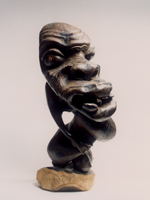I first met Makonde sculptures one day in 1971.
In a folk craft shop in Nagoya, among a display of folk crafts from various countries, mainly from Southeast Asia, I noticed some particularly shining black figures staring out at me.All of the figures - a man hunting, a man holding an axe, a woman carrying a child on her back, and a man carrying a thick piece of wood - were full of life, and they were Makonde carvings.
Each sculpture had a charm that captivated me, and that was the beginning of my Makonde collection. That magic and fascination led me to visit Africa many times to collect, and in 1984, it developed into the opening of the museum (it moved to its current location in Ise City in 1991).
In addition to sculptures, the museum exhibits more than 600 items, including original Tingatinga paintings in vivid colors, Tingatinga school paintings, batik, musical instruments, household items and other folk materials, allowing visitors to feel closer to African culture.
The museum is located in Futami-cho, the gateway to Ise-Shima National Park in Mie Prefecture. It is located on a hill overlooking Ikenoura Bay on the east side, in a wonderful environment close to the Meoto Iwa rocks of Futami-ura and Ise Grand Shrine.
Honorary Director (First Director): Tsuneo Mizuno

The Makonde people, who live in the Makonde Plateau, a vast highland area of 5,000 square kilometers stretching along the border between Tanzania and Mozambique in East Africa, are part of the Bandu ethnic group and have a population of approximately 500,000.
The name Makonde comes from the name of this plateau. At an altitude of 500 to 800 meters above sea level, isolated from the outside world, the ancient Makonde culture allowed their magnificent carving art to blossom. For them, who have a legend that the first father carved wood to create the first mother,
sculptures has a sacred meaning, and they have developed their own unique woodcarving techniques over the course of several centuries to this day.
Today, most Makonde carvings are made from African blackwood, which is abundant in East Africa. This African blackwood is incredibly hard and difficult to carve, but they create rich images from the natural shapes of the branches and roots.
In recent years, the Makonde sculptor community has moved its production base to the economic center of Dar es Salaam and has attracted many talented artists, attracting attention in the global art world.